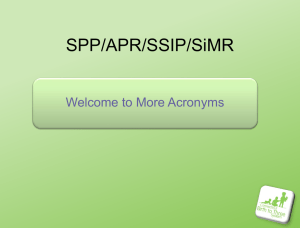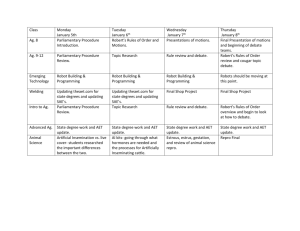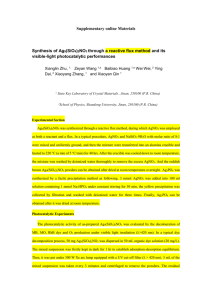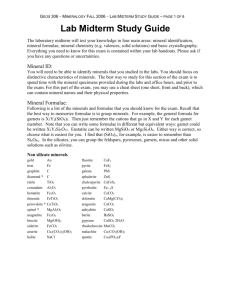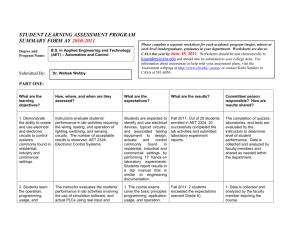Crystal Structure of Silver Chromate Silicate, Ag (CrO )(SiO )
advertisement
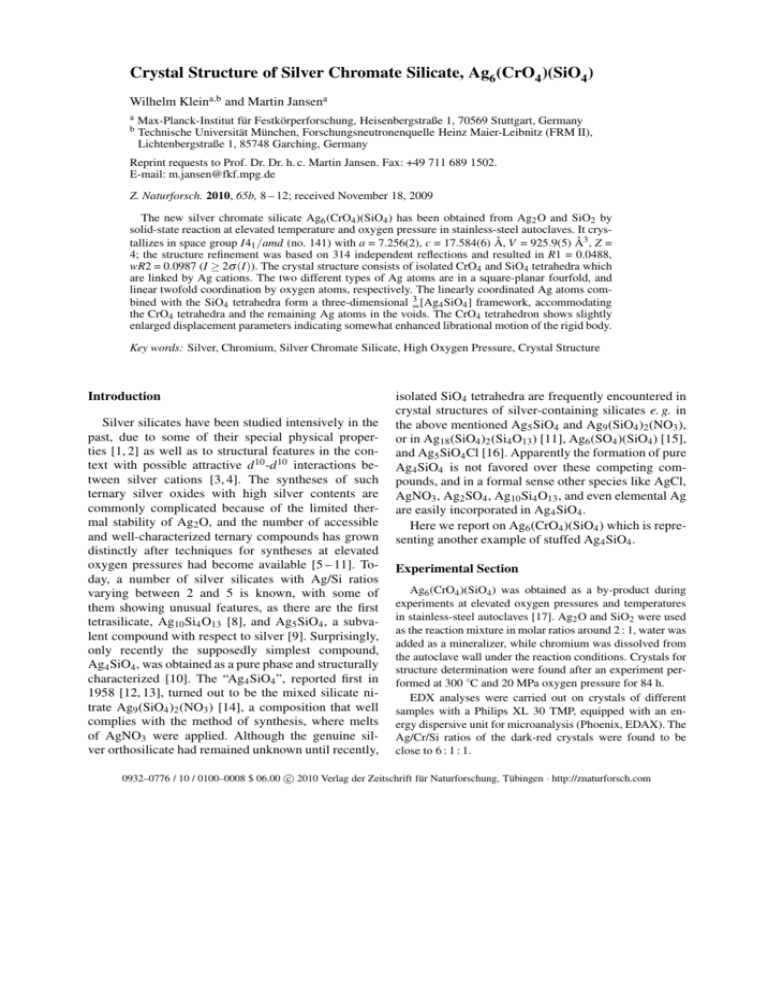
Crystal Structure of Silver Chromate Silicate, Ag6 (CrO4 )(SiO4 ) Wilhelm Kleina,b and Martin Jansena a b Max-Planck-Institut für Festkörperforschung, Heisenbergstraße 1, 70569 Stuttgart, Germany Technische Universität München, Forschungsneutronenquelle Heinz Maier-Leibnitz (FRM II), Lichtenbergstraße 1, 85748 Garching, Germany Reprint requests to Prof. Dr. Dr. h. c. Martin Jansen. Fax: +49 711 689 1502. E-mail: m.jansen@fkf.mpg.de Z. Naturforsch. 2010, 65b, 8 – 12; received November 18, 2009 The new silver chromate silicate Ag6 (CrO4 )(SiO4 ) has been obtained from Ag2 O and SiO2 by solid-state reaction at elevated temperature and oxygen pressure in stainless-steel autoclaves. It crystallizes in space group I41 /amd (no. 141) with a = 7.256(2), c = 17.584(6) Å, V = 925.9(5) Å3 , Z = 4; the structure refinement was based on 314 independent reflections and resulted in R1 = 0.0488, wR2 = 0.0987 (I ≥ 2σ (I)). The crystal structure consists of isolated CrO4 and SiO4 tetrahedra which are linked by Ag cations. The two different types of Ag atoms are in a square-planar fourfold, and linear twofold coordination by oxygen atoms, respectively. The linearly coordinated Ag atoms combined with the SiO4 tetrahedra form a three-dimensional 3∞ [Ag4 SiO4 ] framework, accommodating the CrO4 tetrahedra and the remaining Ag atoms in the voids. The CrO4 tetrahedron shows slightly enlarged displacement parameters indicating somewhat enhanced librational motion of the rigid body. Key words: Silver, Chromium, Silver Chromate Silicate, High Oxygen Pressure, Crystal Structure Introduction Silver silicates have been studied intensively in the past, due to some of their special physical properties [1, 2] as well as to structural features in the context with possible attractive d 10 -d 10 interactions between silver cations [3, 4]. The syntheses of such ternary silver oxides with high silver contents are commonly complicated because of the limited thermal stability of Ag2 O, and the number of accessible and well-characterized ternary compounds has grown distinctly after techniques for syntheses at elevated oxygen pressures had become available [5 – 11]. Today, a number of silver silicates with Ag/Si ratios varying between 2 and 5 is known, with some of them showing unusual features, as there are the first tetrasilicate, Ag10 Si4 O13 [8], and Ag5 SiO4 , a subvalent compound with respect to silver [9]. Surprisingly, only recently the supposedly simplest compound, Ag4 SiO4 , was obtained as a pure phase and structurally characterized [10]. The “Ag4 SiO4 ”, reported first in 1958 [12, 13], turned out to be the mixed silicate nitrate Ag9 (SiO4 )2 (NO3 ) [14], a composition that well complies with the method of synthesis, where melts of AgNO3 were applied. Although the genuine silver orthosilicate had remained unknown until recently, isolated SiO4 tetrahedra are frequently encountered in crystal structures of silver-containing silicates e. g. in the above mentioned Ag5 SiO4 and Ag9 (SiO4 )2 (NO3 ), or in Ag18 (SiO4 )2 (Si4 O13 ) [11], Ag6 (SO4 )(SiO4 ) [15], and Ag5 SiO4 Cl [16]. Apparently the formation of pure Ag4 SiO4 is not favored over these competing compounds, and in a formal sense other species like AgCl, AgNO3 , Ag2 SO4 , Ag10 Si4 O13 , and even elemental Ag are easily incorporated in Ag4 SiO4 . Here we report on Ag6 (CrO4 )(SiO4 ) which is representing another example of stuffed Ag4 SiO4 . Experimental Section Ag6 (CrO4 )(SiO4 ) was obtained as a by-product during experiments at elevated oxygen pressures and temperatures in stainless-steel autoclaves [17]. Ag2 O and SiO2 were used as the reaction mixture in molar ratios around 2 : 1, water was added as a mineralizer, while chromium was dissolved from the autoclave wall under the reaction conditions. Crystals for structure determination were found after an experiment performed at 300 ◦C and 20 MPa oxygen pressure for 84 h. EDX analyses were carried out on crystals of different samples with a Philips XL 30 TMP, equipped with an energy dispersive unit for microanalysis (Phoenix, EDAX). The Ag/Cr/Si ratios of the dark-red crystals were found to be close to 6 : 1 : 1. c 2010 Verlag der Zeitschrift für Naturforschung, Tübingen · http://znaturforsch.com 0932–0776 / 10 / 0100–0008 $ 06.00 W. Klein – M. Jansen · Silver Chromate Silicate, Ag6 (CrO4 )(SiO4 ) Table 1. Crystallographic data and details of the structure determination of Ag6 (CrO4 )(SiO4 ). Formula Mr Crystal size, mm3 Crystal system Space group a, Å c, Å V , Å3 Z Dcalcd , g cm−3 µ (MoKα ), mm−1 F(000), e hkl range Ag6 (CrO4 )(SiO4 ) 855.31 0.15× 0.1× 0.05 tetragonal I41 /amd (no. 141) 7.2563(18) 17.584(6) 925.9(5) 4 6.14 13.7 1536 −9 ≤ h ≤ 9 −9 ≤ k ≤ 9 −19 ≤ l ≤ 22 0.651 6424 314 0.1496 27 0.0488 / 0.0687 0.0987 / 0.1052 1.192 2.05 / −1.77 ((sin θ )/λ )max , Å−1 Refl. measured Refl. unique Rint Param. refined R1(F) (I ≥ 2σ (I) / all data) wR2(F 2 )a (I ≥ 2σ (I) / all data) GoF (F 2 ) ∆ρ f in (max / min), e Å−3 Weighting scheme: 1/[σ 2 (Fo 2 ) + (0.0324P)2 + 54.5123P], where P = (Fo 2 + 2Fc 2 )/3. a 9 www.fiz-informationsdienste.de/en/DB/icsd/depot anforde rung.html) on quoting the deposition number CSD-420804. Results and Discussion Dark-red crystals of Ag6 (CrO4 )(SiO4 ) were obtained as a by-product of preparations originally aiming at silver silicates [10, 16], when elevated oxygen pressures with water added as mineralizer were applied in stainless-steel autoclaves [17]. While silver(I) oxide and silicon dioxide were given as the reaction mixture, the chromium is part of the autoclave steel and was dissolved from the autoclave wall under the reaction conditions. This is in accordance with former observations [19 – 21]: the presence of water is crucial for the formation of chromates in such experiments, and the release of chromium from the autoclave material can be reduced or even completely suppressed by applying mineralizers of higher pH values like diluted aqueous KOH. Furthermore, the formation of chromates is favored by high reaction temperatures and long experiment times in aged, frequently used autoclaves. Table 2. Atomic coordinates and isotropic displacement parametersa (in Å2 ) for Ag6 (CrO4 )(SiO4 ). Atom Ag(1) Ag(2) Cr Si O(1) O(2) a W.-site 16 f 8e 4a 4b 16h 16h x 0.29505(17) 0 0 1/2 0.3116(16) 0 y 0 1/4 3/4 1/4 1/4 0.562(3) z 0 0.12199(14) 1/8 1/8 0.0722(7) 0.077(2) Ueq 0.0216(5) 0.0372(7) 0.0395(17) 0.0113(16) 0.021(3) 0.130(13) Ueq is defined as exp[−8π 2 U(sin2 θ /λ 2 )]. A single crystal suitable for X-ray diffraction was selected and glued onto the tip of a glass capillary. Single crystal data were collected on an IPDS-II diffractometer (Stoe & Cie, Darmstadt, MoKα , graphite monochromator, absorption correction by the integration method). The structure was solved by Direct Methods [18a], and all metal atoms were found at this stage, while the oxygen atoms were localized by Fourier analyses, refinement by full-matrix, and least-squares calculations based on F 2 [18b]. A summary of the data collection and processing, the crystallographic parameters, as well as details on structure solution and refinement are given in Table 1. The atomic coordinates and displacement parameters are shown in Tables 2 and 3. Further details of the crystal structure investigation may be obtained from Fachinformationszentrum Karlsruhe, 76344 Eggenstein-Leopoldshafen, Germany (fax: +497247-808-666; e-mail: crysdata@fiz-karlsruhe.de, http:// Fig. 1. Crystal structure of Ag6 (CrO4 )(SiO4 ) with CrO2− 4 (dark grey) and SiO4− 4 anions (light grey) drawn as tetrahedra. W. Klein – M. Jansen · Silver Chromate Silicate, Ag6 (CrO4 )(SiO4 ) 10 Atom Ag(1) Ag(2) Cr Si O(1) O(2) U11 0.0184(7) 0.0111(10) 0.031(2) 0.010(2) 0.019(6) 0.075(16) Distances M4+ –O(1) [4×] M6+ –O(2) [4×] Ag(1)–O(1) [2×] Ag(1)–O(2)vi [2×] Ag(2)–O(2) [2×] Ag(2)–O(1) [2×] Ag(1)–Ag(1)ix Angles O(1)–M4+ –O(1)i [4×] O(1)– M4+ –O(1)v [2×] O(2)– M6+ –O(2)i [4×] O(2)– M6+ –O(2)ii [2×] O(1)–Ag(1)–O(1)viii Ag(1)–O(1)–Ag(1)x U22 0.0204(7) 0.0550(15) U11 U11 0.017(5) 0.064(15) U33 0.0259(7) 0.0456(14) 0.056(5) 0.013(4) 0.027(7) 0.25(4) U23 −0.0093(5) 0 0 0 0 −0.06(2) U13 0 0 0 0 −0.004(5) 0 U12 0 0 0 0 0 0 Ag6 (CrO4 )(SiO4 ) (M4+ = Si, M6+ = Cr) Ag6 (SO4 )(SiO4 ) [15] (M4+ = Si, M6+ = S) Ag6 (SO4 )(GeO4 ) [22] (M4+ = Ge, M6+ = S) 1.652(12) 1.61(2) 2.218(7) 2.571(18) 2.40(3) 2.424(12) 2.974(3) 1.642 1.464 2.178 2.541 2.395 2.504 2.923 1.769 1.472 2.183 2.569 2.394 2.551 3.024 108.4(4) 111.7(8) 106.1(12) 116(3) 173.8(6) 109.8(5) 109.0 110.5 109.6 109.2 174.1 108.2 108.9 110.7 109.1 110.2 177.0 109.9 Fig. 2. Asymmetric unit and adjacent atoms of Ag6 (CrO4 )(SiO4 ), with ellipsoids drawn at 50 % probability level. Symmetry operations: i 3/4 − y, 3/4 − x, 1/4 − z; ii −x, 3/2 − y, z; iii −3/4 + y, 3/4 + x, 1/4 − z; iv 1/4 + y, −1/4 + x, 1/4 − z; v 1 − x, 1/2 − y, z; vi −x, 1/2 − y, z; vii −x, −1/2 + y, −z; viii x, −y, −z. Ag6 (CrO4 )(SiO4 ) crystallizes isostructurally to Ag6 (SO4 )(SiO4 ) [15] and Ag6 (SO4 )(GeO4 ) [22] with space group I41 /amd and consists of Ag+ cations and 4− isolated CrO2− 4 and SiO4 tetrahedra (Fig. 1). While the SiO4 geometry complies well with that known from related silicates [10, 16], the Cr–O distances appear shorter compared to other chromates [21, 23], and both MO4 units – but particularly the CrO4 units – are slightly flattened to form a bisphenoid with re- Table 3. Anisotropic displacement parametersa in Å2 for Ag6 (CrO4 )(SiO4 ). a Ui j are defined as exp[−2π 2 (U11 h2 a∗2 + U22 k2 b∗2 + U33 l 2 c∗2 + U23 klb∗ c∗ + U13 hla∗ c∗ + U12 hka∗ b∗ )]. Table 4. Selected bond lengths (Å) and angles (deg) for Ag6 (CrO4 )(SiO4 ) and isostructural compounds. spect to their extension along the c axis (see Table 4). Two crystallographically independent silver cations are present in the structure, Ag(2) located slightly above the center of a square of four oxygen atoms and Ag(1) in a dumbbell-like coordination by two O(1) atoms with two more oxygen atoms at a larger distance (see Fig. 2). The dumbbells, exhibiting the shortest Ag–O bonds present in Ag6 (CrO4 )(SiO4 ), form zigzag 1∞ [AgO]− chains along [100] and [010], respectively. The chains are interconnected by SiO4 tetrahedra to give a three-dimensional, formally uncharged 3∞ [Ag4 SiO4 ] framework (Fig. 3). The CrO2− 4 tetrahedron, bearing the lower charge among the two complex anions present, and the Ag(2) atoms are located in channels inside the “Ag4 SiO4 ” framework, and the Ag–O bond lengths are slightly longer than those within the framework. No mixed occupation, neither of the Si, nor of the Cr site, has been found in the structure refinement, although both tetrahedral anions are of very similar size. Obviously the charge difference is sufficient to cause full ordering. The different two- and fourfold silver coordinations observed in the new compound resemble that in the “parent” structures Ag4 SiO4 and Ag2 CrO4 : the fourfold coordination of silver atoms by squares of oxygen atoms is also found in Ag2 CrO4 [23], while in Ag4 SiO4 the silver atoms are coordinated W. Klein – M. Jansen · Silver Chromate Silicate, Ag6 (CrO4 )(SiO4 ) 11 Table 5. Lattice parameters for Ag6 (CrO4 )(SiO4 ) and isostructural compounds. Compound Ag6 (SO4 )(SiO4 ) Ag6 (SO4 )(GeO4 ) Ag6 (CrO4 )(SiO4 ) Fig. 3. Perspective view of the crystal structure of Ag6 (CrO4 )(SiO4 ). To emphasize the 3∞ [Ag4 SiO4 ]n network, Ag(1) atoms and SiO4 tetrahedra are connected and, in the upper part, CrO4 tetrahedra and Ag(2) atoms are removed. Fig. 4. Cuboctahedral surrounding of CrO4 (dark grey) and SiO4 (light grey) tetrahedra by Ag cations in Ag6 (CrO4 )(SiO4 ). Ag(1)–Ag(1) distances in [100], [010] and [001] directions are given with relative changes compared to Ag6 (SO4 )(SiO4 ) in brackets. linearly [10]. As another characteristic feature of Ag6 (CrO4 )(SiO4 ), there is a striking analogy between the 3∞ [Ag4 SiO4 ] framework and the crystal structure of Ag4 SiO4 , where helical 1∞ [AgO]− chains are linked by SiO4 units, but with a different connectivity pattern. As frequently observed in silver-rich compounds [3, 4] a short distance of 2.97 Å between silver cations close to the interatomic distances in elemental silver (2.89 Å) is found. Taken together, the cations form an ordered variant of a distorted cubic close packing with oxygen atoms in tetrahedral voids. Following from that cation packing 4− both, the CrO2− 4 and SiO4 tetrahedra, are surrounded by distorted cuboctahedra of silver atoms (Fig. 4). A a axis (Å) 7.060 7.149 7.256 c axis (Å) 17.660 18.063 17.584 unit cell volume (Å3 ) 880.2 923.2 925.9 Ref. Ref. [15] [22] this work ccp array of the cations and similar cuboctahedral silver environments of tetrahedral MO4 anions are also found in the α - and β -phases of Ag3 VO4 [24, 25] and in Ag4 SiO4 [10]. These compounds only differ in the arrangement of the occupied voids. In β -Ag3 VO4 one kind of the tetrahedral voids is completely occupied, like in Sphalerite, while in α -Ag3 VO4 and in Ag6 (CrO4 )(SiO4 ) half, and in Ag4 SiO4 40 % of both kinds of tetrahedral voids are filled in different ordering schemes. Compared to Ag6 (SO4 )(SiO4 ) [15], the unit cell volumes of the isostructural compounds Ag6 (SO4 )(GeO4 ) [22] and Ag6 (CrO4 )(SiO4 ) are larger, as is to be expected owing to the partially bigger cations (see Table 5). The volume increase is about 5 % in both cases. While for Ag6 (SO4 )(GeO4 ) the expansion is almost isotropic, surprisingly, in Ag6 (CrO4 )(SiO4 ) the volume increase exclusively results from elongation of the tetragonal a and b axes, while the c axis is even the shortest of all three compounds, slightly below the value for Ag6 (SO4 )(SiO4 ). Obviously the c axis is affected to a higher degree by the sizes of the SiO4 and GeO4 tetrahedra. This finding supports the structure description given as a rigid framework consisting of Ag4 MO4 units (M = Si, Ge). As seen in Fig. 3, the SiO4 tetrahedra act as a spacer in the [001] direction between the layers of Ag(1) atoms. These layers of Ag(1) atoms at the special 16 f position with fixed z parameter (top and bottom positions in Fig. 4) define the upper and lower border of the cage including also CrO4 , i. e. in [001] direction the SiO4− 4 and the slightly larger CrO2− tetrahedral have the same space available. As 4 a consequence, the CrO2− tetrahedron in the new 4 compound appears flattened as stated above, while in Ag6 (SO4 )(SiO4 ) and in Ag6 (SO4 )(GeO4 ) all tetrahedral groups are almost undistorted [15, 22; see also Table 4]. The required additional space for the larger CrO2− 4 tetrahedron is created instead mainly in [100] and [010] directions, as can as well be seen from the Ag(1)–Ag(1) distances shown in Fig. 4. Note that in a and b directions the highest relative enlargement is 12 W. Klein – M. Jansen · Silver Chromate Silicate, Ag6 (CrO4 )(SiO4 ) observed at the cuboctahedral edge which is part of the CrO4 cuboctahedron only, and vice versa the smallest relative elongation at the short Ag–Ag distance which is only an edge of the cuboctahedron surrounding SiO4 . Considering the 3∞ [Ag4 SiO4 ] framework, the discussed changes are reflected in the AgO zigzag chains as elongated Ag(1)–O(1) distances and slightly widened Ag(1)–O(1)–Ag(1) angles. As another consequence the “intercalated” Ag(2) atom and the CrO2− 4 tetrahedron show a higher degree of thermal motion expressed by the large displacement parameters of these atoms, particularly of the O(2) atoms. The O(2) ellipsoid has its largest extension (U33 ) perpendicular to the Cr–O bond and almost parallel to the c axis, i. e. the direction of the tetrahedral distortion. Thus the large displacement parameters of these atoms seem to be an expression rather of the internal stress caused by the lack of space than of the lower fixation of the chromate tetrahedron. [1] M. Jansen, H. H. Käs Angew. Chem. 1980, 92, 386 – 387; Angew. Chem., Int. Ed. Engl. 1980, 19, 386 – 387. [2] C. Friebel, M. Jansen Z. Naturforsch. 1984, 39b, 739 – 743. [3] M. Jansen J. Less-Common Met. 1980, 76, 285 – 292. [4] M. Jansen Angew. Chem. 1987, 99, 1136 – 1149; Angew. Chem., Int. Ed. Engl. 1987, 26, 1098 – 1110. [5] M. Jansen Acta Crystallogr. 1977, B33, 3584 – 3586. [6] M. Jansen, K. Heidebrecht Z. Allg. Anorg. Chem. 1991, 601, 5 – 11. [7] C. Linke, M. Jansen Z. Allg. Anorg. Chem. 1996, 622, 486 – 493. [8] M. Jansen, H.-L. Keller Angew. Chem. 1979, 91, 500; Angew. Chem., Int. Ed. Engl. 1979, 18, 464. [9] C. Linke, M. Jansen Inorg. Chem. 1994, 33, 2614 – 2616. [10] W. Klein, M. Jansen Z. Allg. Anorg. Chem. 2008, 634, 1077 – 1081. [11] K. Heidebrecht, M. Jansen Z. Allg. Anorg. Chem. 1991, 597, 79 – 86. [12] E. Thilo, F. Wodtcke Z. Allg. Anorg. Chem. 1958, 295, 247 – 261. [13] F. Wodtcke, K.-H. Jost Z. Allg. Anorg. Chem. 1962, 314, 341 – 344. [14] M. Jansen, K. Heidebrecht Z. Kristallogr. 1987, 179, 347 – 356. [15] H.-L. Keller, H. K. Müller-Buschbaum Z. Anorg. Allg. Chem. 1974, 408, 205 – 208. [16] W. Klein, M. Jansen Z. Kristallogr. – New Cryst. Struct. 2009, 224, 165. [17] W. Klein, J. Curda, E.-M. Peters, M. Jansen Z. Anorg. Allg. Chem. 2006, 632, 1508 – 1513. [18] a) G. M. Sheldrick S HELXS-97, Program for the Solution of Crystal Structures, University of Göttingen, Göttingen (Germany) 1997. See also: G. M. Sheldrick Acta Crystallogr. 1990, A46, 467 – 473; b) G. M. Sheldrick S HELXL -97, Program for the Refinement of Crystal Structures, University of Göttingen, Göttingen (Germany) 1997. See also: G. M. Sheldrick Acta Crystallogr. 2008, A64, 112 – 122. [19] W. Klein, J. Curda, K. Friese, M. Jansen Acta Crystallogr. 2002, C58, i23 – i24. [20] W. Klein, J. Curda, M. Jansen Acta Crystallogr. 2005, C61, i63 – i64. [21] J. Curda, E.-M. Peters, W. Klein, M. Jansen Z. Kristallogr. – New Cryst. Struct. 2001, 216, 180. [22] K. Heidebrecht, M. Jansen Z. Kristallogr. 1991, 196, 294 – 295. [23] M. L. Hackert, R. A. Jacobson J. Solid State Chem. 1971, 3, 364 – 368. [24] T. A. Albrecht, C. L. Stern, K. R. Poeppelmeier Inorg. Chem. 2007, 46, 1704 – 1708. [25] R. E. Dinnebier, A. Kowalevsky, H. Reichert, M. Jansen Z. Kristallogr. 2007, 222, 420 – 426. Acknowledgements We gratefully acknowledge Dr. B. Hinrichsen for recording the X-ray single crystal data, and Mrs. E.-M. Peters for performing the EDX analyses.


